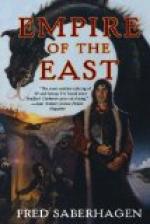The River Moraca is a large mountain torrent, into which the Zeta flows only a short distance away from the town. It rushes over great boulders, forming here and there formidable rapids, between two deep banks, which, without any warning, break off suddenly from the flat and form precipitous sides fully two hundred feet deep. Two or three hundred yards away, no gap or break in the plain is observable. Sometimes the river swells almost to the top of its banks, and then the effect must be terrible. There is a ford near Podgorica, which the peasants use to avoid the long detour by the bridge, but woe to the man who makes a false step. Three women, carrying loads of wood, lost their footing during our stay, and were drowned. In its waters we swam every evening, and even in midsummer, when the river is low, the strength of the current required an expert and powerful swimmer to breast it, and it was invariably very cold.
[Illustration: THE VIZIER BRIDGE]
The bridge, built by an old Turkish Vizier many, many years ago, is most picturesque, and completely in keeping with the rocky banks and the foam-flecked, emerald-green waters rushing beneath. From this bridge a man once sprang into the depths below, to show that he was not intoxicated. As a matter of fact he was, but he emerged dripping a hundred yards lower down, unhurt and at least in his right mind.
There used to be a deep indentation in a stone of the bridge parapet—during our stay in the country it has been plastered up—which credulous Montenegrins relate to be the cut of a Turkish horseman pursuing a fleeing Montenegrin. The story goes that the Turk severed the Montenegrin’s head from his body, and so violent was the stroke that he cut into the stone wall as well.
Again, just before the town, two slabs, standing exactly thirty paces apart, mark a similar episode, and the headless man is said to have run that distance before falling. This legend—which, furthermore, has many eye-witnesses still living in the town who swear to the truth—is more capable of belief if one takes into consideration the flight of a decapitated fowl in any of our poultry yards.
The road entering Podgorica is very similar in appearance to that which leads into Cetinje, only the first impressions are considerably wilder and more uncivilised than that of the capital. Hundreds of Turks and Albanians are smoking their evening “tchibouque” in the streets, and scowl in no friendly manner at the stranger. Some of them, namely, the merchant class, are, however, excellent people, travelled and educated, as we found out afterwards. The Albanian and Turk are the enterprising merchants of Montenegro, and improve on acquaintance, which is sometimes necessary.
We had a lonely, solitary feeling as we drove through the crowd of loiterers, and were glad to descend at a presentable-looking hostelry. How often first impressions are wrong we proved to the full in this instance.




